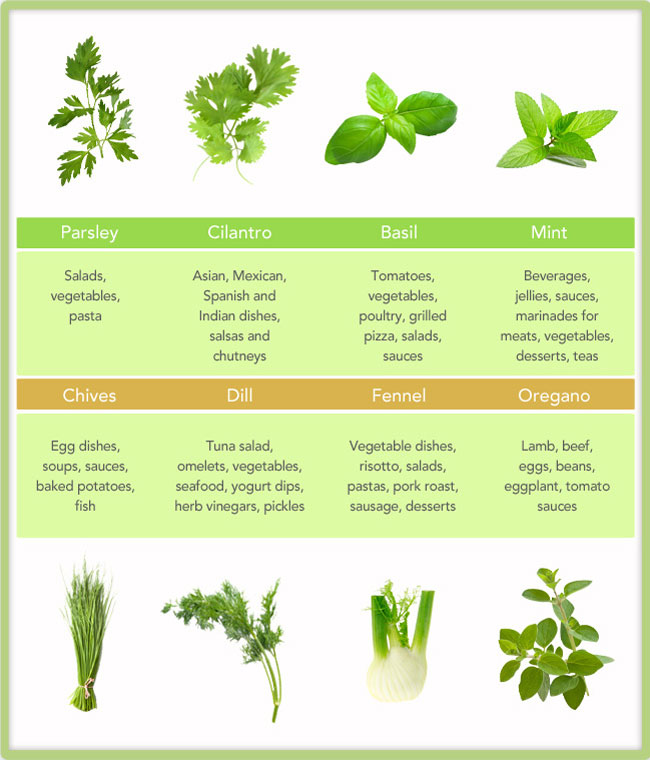Next time you walk into the kitchen and smell something delicious that makes your mouth water, or you have a fresh salad that’s got something extra yummy in it, odds are that you can blame it on fresh green herbs—fragrant, flavorful, and actually good for you. Sure, you can get the dried version in a jar, but fresh herbs bring a whole new dimension to healthy cooking.
Used sparingly or with a heavy hand, fresh green herbs are delicious and available year-round in your local market’s produce section. Experiment with different kinds, and use your sniffer . . . you should be able to smell a full, fresh fragrance from bright, perky greens that don’t show signs of brown spots or yellow, droopy sogginess. Better still, with a little sunshine and a few pots, you can start your own easy-to-maintain herb garden. Then you can be 100 percent sure they’re fresh!
Not sure where to start? Here are eight awesome herbs that’ll make your recipes sing and your health soar.
 Parsley. This curly-leafed herb is one that you’ve seen just about everywhere. It has almost twice the carotenoid content of carrots. It is rich in antioxidants which have been shown to help slow down the effects of aging and may help prevent coronary artery disease. Parsley also contains apigenin—a phytonutrient shown to have substantial anti-cancer properties, by working to inhibit the formation of new tumor-feeding blood cells. Furthermore, Mediterranean-style parsley salad—often known as tabouli—is amazing!
Parsley. This curly-leafed herb is one that you’ve seen just about everywhere. It has almost twice the carotenoid content of carrots. It is rich in antioxidants which have been shown to help slow down the effects of aging and may help prevent coronary artery disease. Parsley also contains apigenin—a phytonutrient shown to have substantial anti-cancer properties, by working to inhibit the formation of new tumor-feeding blood cells. Furthermore, Mediterranean-style parsley salad—often known as tabouli—is amazing!
Cilantro. Basically a flat-leaf parsley, but with a very different aroma and taste, these delicate 1/4-inch leaves help cut cholesterol, reduce high blood sugar, promote detoxification of the blood, and are a good source of vitamin A and vitamin C. Chopped cilantro (and a squeeze of lime) on just about every savory Mexican and Middle Eastern dish is a delicious mix of flavors!
Basil. These wide, slightly curly leaves are a good source of vitamin A and magnesium. They also contain iron, calcium, potassium, and vitamin C. Basil has anti-inflammatory and anti-bacterial properties that come from its high volatile (aromatic) oils content, which include—to name a few—linalool, estragole, and limonene. Many studies have shown that in the presence of these oils, the growth of bacteria such as listeria and Staphylococcus aurea (two big bad boys in the world of dangerous infections) have been noticeably restricted. And as we all know, pesto totally rocks on pasta!
Mint. These small, slightly fuzzy, wrinkly leaves, like their cousin basil, have been shown to have strong anti-microbial properties, thanks to the oils within. When put head to head with bacteria such as Salmonella and methicillin-resistant Staphylococcus aurea (MRSA), mint oils inhibited the growth of these little monsters. Mint also soothes your tummy and can be helpful in lessening the effects of conditions like irritable bowel syndrome and dyspepsia, by its ability to help relax the smooth muscles in all these areas. Mint tea, anyone? How about a refreshing and fun mint julep . . . mmm!
Chives. This pungent, slightly spicy herb is related to garlic and leeks. Like garlic, chives are known for their high allicin content—the antioxidant compound that’s been shown to help scrub your system clean of toxins and have anti-aging properties. And it does a number on bacterial and fungal agents, much to our benefit. Allicin is also what gives chives their distinctive odor. Nutritionally, chives are a good source of beta-carotene, potassium, vitamin K, calcium, and folic acid, plus trace amounts of iron and vitamin B.
Primarily used raw, chives are most often sprinkled on hot foods like baked potatoes, and of course, soups and pasta. Experiment by sprinkling fresh-chopped chives on any savory dish you make—soup, veggies, fish, or beans . . . delicious!
Dill. This plant with delicate wispy fronds for leaves has one of the most distinctive tastes and aromas from our list—you could recognize it anywhere. It’s high in calcium, manganese, iron, fiber, and magnesium. Like basil and mint, dill contains volatile oils such as limonene and anethofuran that have antioxidant properties. It has other healing properties, too. Ancient Greek and Roman soldiers would use burnt dill seeds on their wounds to heal more quickly.
Classically, dill is used as a cooking ingredient/garnish for any fish dish and as part of the pickling recipes for, well, dill pickles. A delicious dipping sauce is made with light plain yogurt, grated cucumbers, fresh garlic, and chopped dill.
Fennel. Looking like dill on steroids, fennel has a completely different taste—that of black licorice! Its large, bulbous root end is the part used most—you can peel the stalks off like celery, and they can be sliced and prepared in the same way. Or you can slice the bulb very thinly and either leave the slices intact, or break each slice into smaller pieces. The upper part of this plant—the dill-like part—can be used as edible garnish, or added into any recipe. It’s a good source of vitamin C, dietary fiber, potassium, and manganese. Plus, there are small amounts of iron, calcium, and vitamin A thrown in for good measure. Fennel has been shown to have antioxidant and anti-inflammatory properties, and may help to lower cholesterol due to its high fiber content. A super-simple and refreshing way to enjoy fennel is to thinly slice a stalk against the fibers and lightly drizzle with olive oil and a squeeze of lemon. Or just nibble on the ungarnished slices. Chilled fennel is a surprising treat.
Oregano. What list of herbs is complete without this staple of hundreds of cuisines from around the world? This is one herb that is very commonly found in dried form, but if you can find it fresh in your local market’s produce section, it’s a wonderful thing. Woody, thick stalks feature dozens of fuzzy curly little leaves measuring about 1/4 to 1/2 inch long. Oregano is an excellent source of vitamin K, and a good source of vitamins A and C. It also contains decent amounts of iron, manganese, and folate. Together with oils, like thymol, that have been shown to be anti-bacterial and anti-fungal in nature, the nutrients found in oregano pack a real power punch—even in small amounts.
Try mincing fresh leaves very finely, and sprinkle on slices of tomato and cucumber, drizzled with a touch of olive oil—a very Mediterranean-style snack.
Although fresh green herbs are generally used sparingly in any dish, if used on a regular basis, you can benefit from all the good stuff packed into these fragrant plants. Some might not tickle your taste buds; others might totally have your tongue falling head over heels in love. Experiment as much as you can. Most herbs—even when sold in those little fancy plastic packages—are not that costly, especially considering you’ll be using them in small amounts and they will last for at least several days in the refrigerator.
A Leaf for Every Occasion: How to Make the Most of Your Herbs
Parsley – Salads, vegetables, pasta
Cilantro – Salsas, chutneys
Basil – Tomatoes, vegetables, poultry, grilled pizza, salads, sauces
Mint – Beverages, jellies, sauces, marinades for meats, vegetables, desserts, teas
Chives – Egg dishes, soups, sauces, baked potatoes, fish
Dill – Tuna salad, omelets, vegetables, seafood, yogurt dips, herb vinegars, pickles
Fennel – Vegetable dishes, risotto, salads, pastas, pork roast, sausage, desserts
Oregano – lamb, beef, eggs, beans, eggplant, tomato sauces
